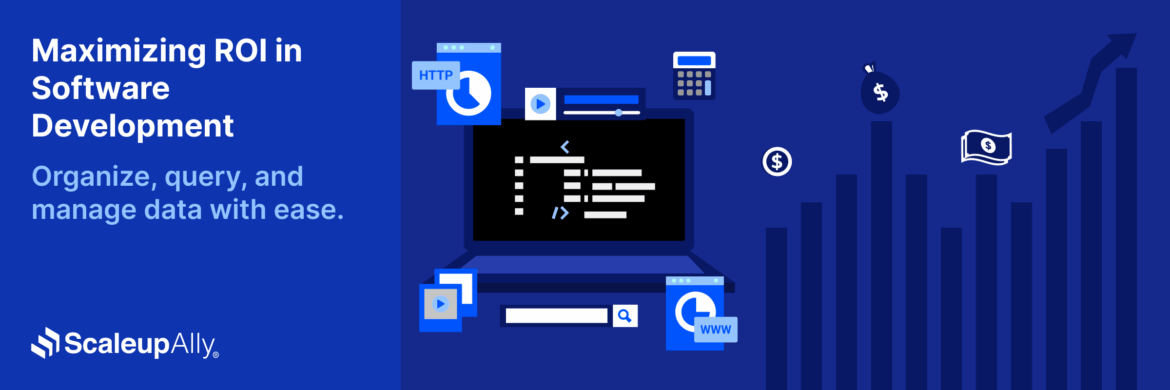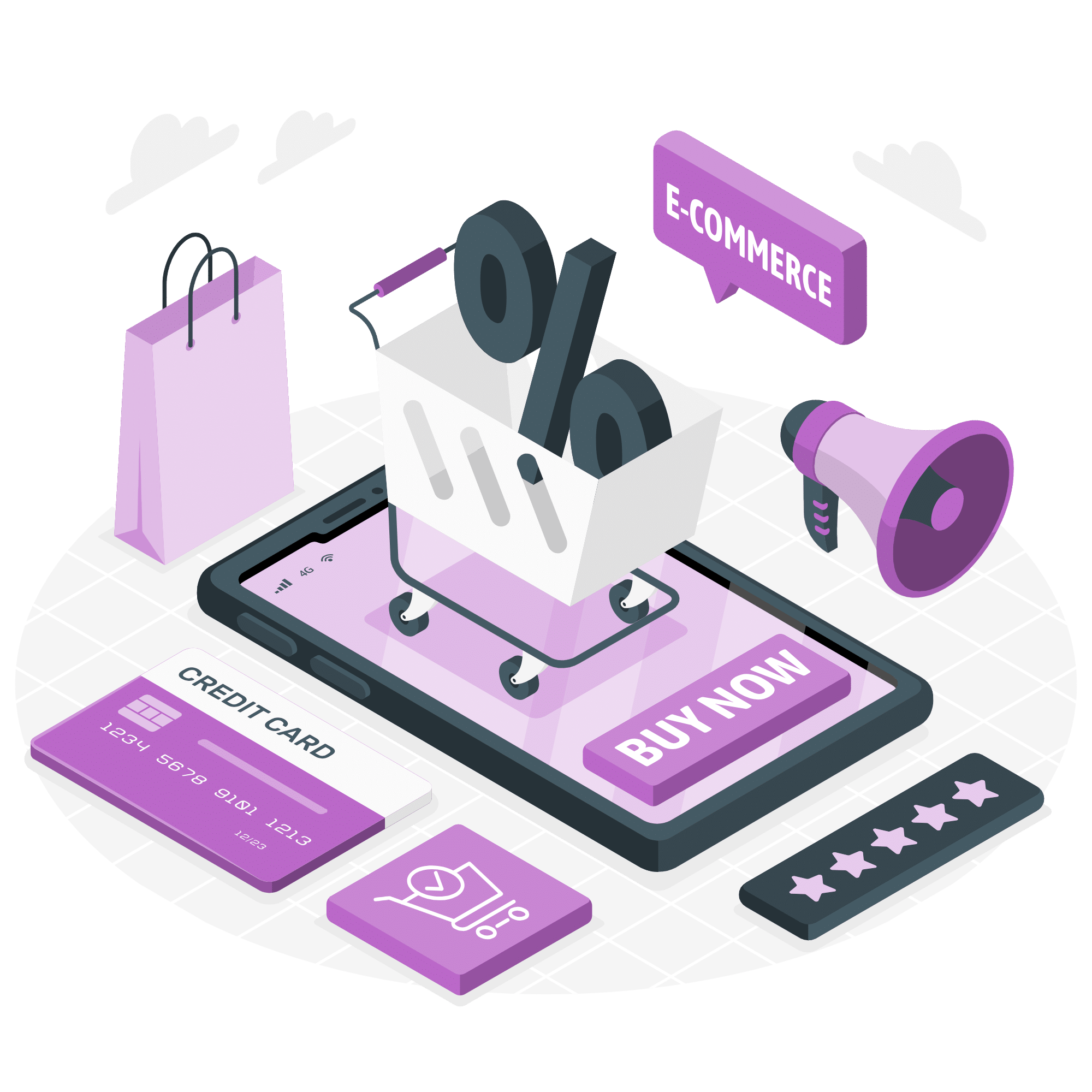
E-Commerce Software Development: Key Features and Cost
Suprabhat Sen | February 3, 2025 , 17 min read
Table Of Content
Developing a successful e-commerce platform includes but is not limited to the technology. Everything from the front-end design to the user-experience(UX) to backend integrations, databases, security protocols, and ensuring the platform is erudite, scalable and efficient.
In this comprehensive guide to e-commerce development, we’ll explore the components that come together to create an ecommerce platform, discussing all the essential tools, off-the-shelf solutions or custom development, the best practices and more. All-in-all, this is your one-stop guide to e-commerce development.
Key Takeaways
- Understand the basics of E-Commerce Software Development, its types and applications.
- Learn the must-have features of a successful e-commerce platform, be it payment gateways or inventory management.
- Compare SaaS vs. custom-built solutions to determine the best fit for your business.
- Get insights into the cost factors influencing eCommerce software development.
- Understand how security, scalability, and third-party integrations formulate a robust e-commerce platform.
What is E-Commerce Software Development?
- What is E-Commerce Software Development?
- Benefits of E-Commerce Software Development
- The Uses of E-Commerce Software
- Key Features of a Successful E-Commerce Software
- How Does Software Work for E-Commerce Businesses?
- The End-to-End E-Commerce Software Development Process
- Costs Involved in E-Commerce Software Development
- How Can ScaleupAlly Help?
- Conclusion
- Frequently Asked Questions
E-commerce software development involves developing software that enables online stores to manage their business. This includes setting up web storefronts, handling payments and inventory, processing orders, providing customer service tools, and integrating with other systems like shipping services or CRMs.
E-commerce software can range from Software-as-a-Service(SaaS) to On-Premise solutions. The choice between these three boils down to your budget, scale, and several other factors. The software you choose will significantly influence the costs involved in running your website. You need to answer various questions in your mind before choosing the software development type like most essential features you need, the core functionality of your application, and the bandwidth your site consumes.
Every software is meant to cater to different operational requirements. They enable you to build digital storefronts, process payments, list items, and other functions. However, each of them varies due to different software models.
These models define how the software is hosted, managed, and utilized by businesses.
1. On-Premises Software Development
This type is hosted within the physical premises of the business itself. The company owns the software, taking full responsibility for its management, updates, and configurations. There’s a dedicated team which makes sure that the system runs smoothly and remains up-to-date, but this approach is heavy on cloud infrastructure and resources.
2. Custom Software Development
Custom platforms are tailored from the ground up to align perfectly with a business’s unique requirements. They provide unmatched flexibility, scalability, and the ability to integrate advanced features. For enterprises prioritizing innovation, a custom eCommerce platform—developed by trusted eCommerce development company—can drive differentiation and long-term growth.
3. Cloud-Based E-Commerce Development
The cloud-based software is accommodated by an external provider on their infrastructure, and the service provider handles updates, maintenance, and configuration. Businesses subscribe to the software, eliminating the need for internal hosting or extensive IT resources, making it especially appealing to startups and small businesses.
Cloud-based e-commerce development refers to building and deploying online stores on cloud-hosted platforms rather than on-prem servers. This model allows businesses to use third-party infrastructure, reducing the need for in-house IT teams. Cloud-based e-commerce solutions, often delivered as Software-as-a-Service (SaaS) platforms, provide scalability, security, and automatic updates, making them ideal for startups and businesses aiming for rapid growth.
4. SaaS-Based E-Commerce Solutions
SaaS platforms like Shopify, BigCommerce, or Wix are templatized solutions that simplify the process of launching an online store. They’re ideal for businesses seeking quick hands-on deployment and minimal upfront investment. While convenient, their limited customization options can sometimes hinder businesses with niche or complex requirements.
Balancing SaaS vs. Custom-Built eCommerce Solutions
Choosing between SaaS and custom ecommerce software development depends on factors like budget, business complexity, and long-term goals. SaaS solutions are cost-effective and offer quicker deployment, ideal for small businesses.
Custom platforms, on the other hand, provide unmatched flexibility, enabling enterprises to tailor features, design, and integrations precisely to their needs. Partnering with experienced developers and adopting an agile methodology ensures that custom solutions remain adaptable and future-proof.
Benefits of E-Commerce Software Development
Custom and SaaS-based e-commerce platforms both provide significant advantages, depending on your needs:
- Improved customer experience with user-centric designs that offer intuitive navigation, personalized recommendations, and secure checkout processes, boosting customer satisfaction and retention.
- Automated processes, such as inventory tracking and order fulfillment, reduce human error and free up time for strategic decision-making.
- As businesses grow, platforms can be scaled to accommodate higher traffic, larger inventories, and new features like multilingual support or regional pricing.
- Seamless integration with third-party tools like Customer Relationship Managements (CRM), Enterprise Resource Planning (ERPs), and marketing platforms ensure that operations remain cohesive.
- By enabling businesses to sell across borders, eCommerce software expands market reach, opening new revenue streams.
The Uses of E-Commerce Software
E-commerce software serves as a backbone for various business operations, ensuring smooth and secure online transactions. Its primary uses include:
- Retail sales management by streamlining the entire purchasing process, from browsing to checkout.
- Inventory control, including tracking stock levels, product locations, and reordering schedules.
- Facilitating marketing and promotions through discount campaigns, loyalty programs, and targeted advertisements.
- Storing customer data and preferences to offer tailored experiences through customer relationship management.
- Providing real-time insights into sales trends, customer behavior, and revenue performance through analytics and reporting.
Key Features of a Successful E-Commerce Software

To truly outperform others in the competitive online marketplace, eCommerce software must include the following critical features:
1. Comprehensive Payment Gateway Support
A versatile payment gateway is critical for catering to a wide range of customer preferences. Modern eCommerce platforms must support multiple payment methods. Common ways include credit and debit cards, digital wallets and even cryptocurrencies.
Ensuring secure payment processing through PCI DSS compliance and employing fraud detection measures like tokenization and 3D Secure protocols builds customer trust and safeguards sensitive data. For entrepreneurs and enterprises, integrating such diverse payment options helps to expand market reach and accommodate varying customer needs.
Also read: 5 Cheapest eCommerce Payment Gateways
2. Efficient Product Catalog Management
An intuitive product catalog management system helps in organizing products into categories and subcategories. High-quality images, zoom functionality, and detailed descriptions enable the shopping experience to be even better.
This is the reason customers are able to find and evaluate products conveniently. Features like bulk product uploads, multilingual support, and SEO-friendly attributes are valuable for businesses looking to scale. Additionally, integrating a content management system (CMS) allows teams to update product listings and promotional content effortlessly.
3. Real-Time Inventory Tracking
Inventory management is at the heart of eCommerce efficiency. Real-time inventory tracking prevents stockouts or overstocking, directly impacting customer satisfaction and operational costs. Advanced platforms integrate with supplier systems to automate reordering, ensuring optimal stock levels at all times.
Features such as low-stock alerts, demand forecasting, and synchronization across multiple sales channels empower businesses to stay ahead in competitive markets.
4. Mobile Responsiveness for Seamless Accessibility
In thes times with mobile commerce accounting for a significant portion of online sales, having a mobile-responsive eCommerce platform is no longer optional. A responsive design ensures a seamless shopping experience across smartphones, tablets, and other devices.
Mobile-optimized checkout processes, touch-friendly interfaces, and fast-loading pages are crucial for reducing cart abandonment rates and improving customer retention. For businesses leveraging custom-built solutions, agile development methodologies can ensure continuous improvements in mobile usability.
5. Robust Security Measures
Security is non-negotiable in eCommerce platforms. When you’re dealing with something so important, SSL encryption needs to safeguard the data. Two-factor authentication adds another layer of additional security and relieves both the customers and the administrators.
Also, compliance with all the necessary legal standards like GDPR justify the fact that consumer data is handled responsibly. This is to maintain the reputation and avoid any charges or penalties.
6. Third-Party Tool Integration
These days, e-commerce platforms need to be equipped with third-party integrations. Be it CRMs, ERPs or marketing automation tools, these are the integrations which help us extract the most functionality out of the e-commerce platform.
For entrepreneurs and businesses using SaaS solutions, API-based integrations offer scalability and flexibility without compromising core platform performance. Custom eCommerce platforms can further tailor these integrations to meet unique business needs.
7. Advanced Search and Filtering Options
Sophisticated search and filtering tools substantially improve the user experience. Auto-suggestions, natural language processing (NLP), and filters like pricing, brand, size and colour help users find the products they want. Implementing AI-driven recommendations based on user behaviour or browser history can help personalise the buying experience and increase conversion rates.
8. Scalability for Growth
Businesses expand and so do platform requirements. E-Commerce platforms need to remain robust to ensure that they are still up and running even when the traffic spikes, there is a lot of information like a vast catalogue of products and more.
This is ensured by having a modular architecture which is mostly available according to needs in custom-built platforms. So, new features will come with no downtime in business. Therefore, proper and scalable e-commerce platform development is very important for a growing company.
How Does Software Work for E-Commerce Businesses?
E-commerce software acts as an ecosystem that connects various business functions. For instance:
- Customers interact with the frontend of the application to browse products, add the products to the cart, and finalise their purchases.
- Backend operations are used to manage inventory, process payments, and handle order fulfillment.
- Third-party integrations, such as tools for shipping providers or analytics platforms, enhance operational efficiency.
Together, these components ensure smooth workflows and elevate customer experience.
The End-to-End E-Commerce Software Development Process
There is a lot that it takes to develop an end-to-end e-commerce software. It includes but is not limited to a lot of experience and a thorough understanding of the business. The steps you need to undertake in order to build e-commerce software are as follows:
1. Research & Ideation
You need to identify the value proposition in your offering. Analyze the existing e-commerce players and identify the user needs which are still unmet. What special did Blinkit do, they addressed the need for convenient grocery delivery. Analyze competitor user feedback also, so that you can fill those gaps. Utilize online tools like BizFacts to gather data relevant to your industry.
You can also go ahead conducting user surveys through platforms like KeySurvey and SurveyMonkey to understand target audience preferences and needs. All these insights will together help you determine resource requirements (financial and technical) for your e-commerce solution.
2. Define Your E-Commerce Business Model
You need to niche down and choose the model which is most suitable for your way of conducting the business. Some of the models are:
- Outsourced Delivery: Utilize third-party fulfillment services (e.g., Amazon FBA).
- Drop Shipping: Sell products without holding inventory, focusing on marketing and brand building.
- Warehousing: Store and ship products directly from your own warehouse. Inventory costs are involved but you have greater control over your management, as its completely centralized.
- Subscriptions: Offer recurring services to customers (e.g., Netflix, Spotify). SaaS business owners mostly choose the subscription route.
3. Key Considerations for E-Commerce Development
- Personalized Experience: Use big data and AI to personalize user experiences, such as product recommendations (e.g., Netflix).
- Augmented Reality (AR): Elevate the shopping experience with AR features, allowing customers to visualize products. This idea was far-fetched a couple of years ago but now its being implemented widely. For example, Lenskart also provides a 3D try-on feature as a differentiator.
- One-Click Payments: Ease the checkout process and reduce payment friction with convenient one-click payment options.
- Robust Security: You need to implement very stringent security measures to protect the user data and prevent frauds.
4. Building Your Development Team
You need to assemble and handle a skilled team of UI/UX Designers, Front-end Developers, Back-end Developers, App Testers, DevOps Engineers, SEO Experts, Business Analysts and Project Managers. Now this can be a lot, but honestly it’s needed to develop something of the industry grade. Therefore, for most companies, it’s a wise option to Consider partnering with a reputable software development company for access to vetted talent and guaranteed quality.
5. Choosing the Right Development Approach
The development approach depends on the kind of software you’re building. If you choose to develop an e-commerce website, then you can consider utilizing technologies like JavaScript, HTML, CSS, PHP, Ruby, Node.js, and e-commerce platforms (WooCommerce, Magento). Focus on database management (MySQL, MongoDB) and API integrations.
However, in the case of E-commerce Mobile Apps, you need to develop native apps for iOS (Swift/Objective-C, Xcode) and Android (Java/Kotlin, Android Studio). A better option would be to explore cross-platform frameworks like Flutter and React Native which can suffice both requirements.
6. Develop a Minimum Viable Product (MVP)
Many companies consider building MVPs in the first stage to study and identify the product-market fit. The AGILE framework is widely used to build and incrementally refine the product in the further versions.
Essential MVP Features include:
- User login/signup
- User profiles
- Search functionality
- Product filters
- Payment gateway integration
- Checkout process
So, if you’re just getting started, this might serve as the bare minimum which you need.
7. E-commerce Testing
You need to conduct thorough testing in the form of Functional testing, Security testing, Usability testing, Database testing to ensure that the product development has covered all the possible edge-cases which might arise while using the software. You can utilize testing tools and A/B testing to optimize performance and user experience.
8. Deployment, Monitoring, and Maintenance
After the thorough testing, once you are satisfied, you can do the deployment of your e-commerce platform to a production grade environment. Implement a Content Delivery Network(CDN) to increase the website loading speeds. You need to continuously monitor application performance, gather user feedback, and make ongoing improvements based on user insights.
Costs Involved in E-Commerce Software Development
Developing e-commerce software involves a wide range of costs. SaaS solutions like Shopify or BigCommerce offer affordable monthly subscriptions, but transaction fees and necessary plugins can increase expenses over time.
In contrast, custom development typically costs between $10,000 and $100,000, with the final price determined by factors such as complexity, desired features like advanced analytics dashboards, AI-driven chatbot and third-party integrations to name a few. The expertise of the team also defines the cost of software development for ecommerce.
There are several factors that influence the cost of developing an e-commerce software. Firstly, the choice between whether you want to choose an off-the-shelf SaaS platform (like Shopify or BigCommerce) or go for a custom development solution. SaaS options offer tiered monthly subscriptions, but transaction fees and the need for premium plugins can escalate costs over time.
On the other hand, custom development, while initially more expensive, may range from $10,000 and even go as high as $100,000. Perhaps, for the price, it offers greater flexibility and long-term cost savings by avoiding recurring subscription fees.
Secondly, developer rates vary significantly depending on their location. North American developer teams generally command higher rates while the developers in Eastern Europe or India might do it for a much affordable price. This geographical disparity in labor costs due to Purchase Power Parity can substantially impact the overall development budget.
E-commerce platform development cost is also dependent on the number of features that you desire. The algorithms you want implemented, some advanced functionalities such as augmented reality (AR) product previews, dynamic pricing algorithms, or complex integrations require specialized skills and significantly increase development time and costs.
Finally, ongoing maintenance costs should be factored into the budget. These costs include hosting expenses, regular software updates to ensure compatibility and security, and ongoing cybersecurity enhancements to protect the platform and customer data—making a realistic cost estimate essential for long-term planning.
How Can ScaleupAlly Help?
At ScaleupAlly, we specialize in crafting tailored eCommerce solutions that align with your business objectives in a way that wows. Our services include:
- Custom development to build platforms that prioritize user engagement, scalability, and innovation.
- SaaS optimization by enhancing platforms through plugins, improved performance, and customized designs to reflect your brand identity.
- Integration services that connect your eCommerce software with tools like CRM, ERP, and analytics platforms for end-to-end efficiency.
- Post-launch support to ensure your platform stays competitive through updates, feature rollouts, and security enhancements.
With ScaleupAlly, you gain a trusted partner dedicated to turning your vision into a reality.
Conclusion
E-Commerce software development is the backbone of successful online businesses. Whether you’re a startup seeking quick deployment or an enterprise aiming for custom solutions, understanding the development process, costs, and features is key to making informed decisions.
Partnering with an experienced development team ensures your platform meets current demands while remaining future-ready.
Frequently Asked Questions
Q: What is eCommerce software development?
ECommerce software development involves creating platforms that make businesses capable of selling their products or services online, integrating essential features like payment gateways, inventory management, and third-party tools.
Q: What is the best eCommerce development platform for a startup?
Startups often benefit from SaaS platforms like Shopify or WooCommerce, which are cost-effective and offer quick setup with minimal technical expertise.
Q: How long does it take to build eCommerce software?
Development timelines vary widely. SaaS-based e-com solutions can be ready in days, while custom-built platforms may take 3-12 months, depending on complexity.
Related Blogs

Software Development Timeline: Phases, Duration & Estimation Guide
Understand the software development timeline with phase durations, key factors, hidden delays, and practical methods to estimate project time.
Suprabhat Sen
Nov 29 ,
16 min read

Software Development Cost Estimation Guide: What’s Included & What Affects the Price
Explore software development cost components, major pricing factors, and practical estimation methods to plan your project accurately from start to finish.
Suprabhat Sen
Nov 29 ,
14 min read

Calculating ROI for Software Development: A Detailed Guide
Discover proven strategies and practical tips to enhance the ROI for software development projects. Learn how to measure success and increase profitability.
Manu Jain
Nov 25 ,
19 min read



